Last updated on
Discover effective ways to protect your luxurious leather couches from the relentless claws of your feline friends.
Cats are lovable creatures that bring joy and companionship to our lives. However, as much as we adore them, they can also be a source of frustration when it comes to furniture.
One common concern among cat owners is whether or not their furry friends will scratch their leather couches. If you’re a cat owner who loves your leather furniture, you may be wondering if there’s anything you can do to prevent your feline friend from leaving their mark on your beloved couch.
In this article, we’ll explore the question “do cats scratch leather couches?” and provide some tips on how to protect your furniture while still enjoying the company of your cuddly companion.
Table of Contents
Cats and Leather Furniture

Leather furniture is a popular choice for many homeowners due to its durability, comfort, and aesthetic appeal. However, it’s also an expensive investment that requires proper care to maintain its quality over time.
If you’re a cat owner who loves leather furniture, you may be wondering if your furry friend will scratch or damage your couch.
The truth is that cats are natural scratchers and they need to sharpen their claws regularly. Unfortunately for us humans, this often means our beloved furniture becomes the target of their scratching instincts.
While some cats may not show any interest in leather couches at all, others might find them irresistible due to the texture or smell of the material. It’s important as a pet owner to understand why cats scratch in order to prevent unwanted behavior from occurring on your prized possessions.
Reasons Cats Scratch

Scratching is an instinctive behavior that helps cats to mark their territory, stretch their muscles, and sharpen their claws. It’s also a way for them to relieve stress or anxiety.
When it comes to leather furniture specifically, cats may be attracted to the texture of the material or simply enjoy scratching something that feels good under their paws.
It’s important as cat owners not only understand why our feline friends scratch but also provide them with appropriate outlets for this behavior while protecting our furniture at the same time.
Do Cats Scratch Leather?

As a result, many cat owners worry about the damage that cats can cause to leather furniture. The good news is that not all cats scratch leather couches or other types of furniture.
Some cats may prefer scratching on carpeted surfaces or wooden posts instead.
However, it’s important to note that some factors can increase the likelihood of your cat scratching your leather couches. For example, if your cat has already scratched one area of the couch and left its scent behind with pheromones from glands in its paws (which only other felines can detect), then it may be more likely to return and continue scratching there again.
Some breeds like Siamese or Bengal have a higher tendency towards destructive behavior than others due to their active nature.
Do Cats Scratch Leather Furniture More Than Wood Furniture?

The answer is that it depends on the individual cat and their preferences. Some cats may prefer the texture of leather over wood, while others may not show any interest in scratching either material.
However, there are some factors that can make leather couches more appealing to cats. For example, if your couch has a smooth surface or shiny finish, this can attract your cat’s attention and encourage them to scratch.
On the other hand, wooden furniture with rougher surfaces or natural textures like bark or knots might be less attractive for scratching purposes.
Ultimately though whether they prefer one type of material over another will depend on each individual feline personality and preference.
Identifying Scratch-prone Couches
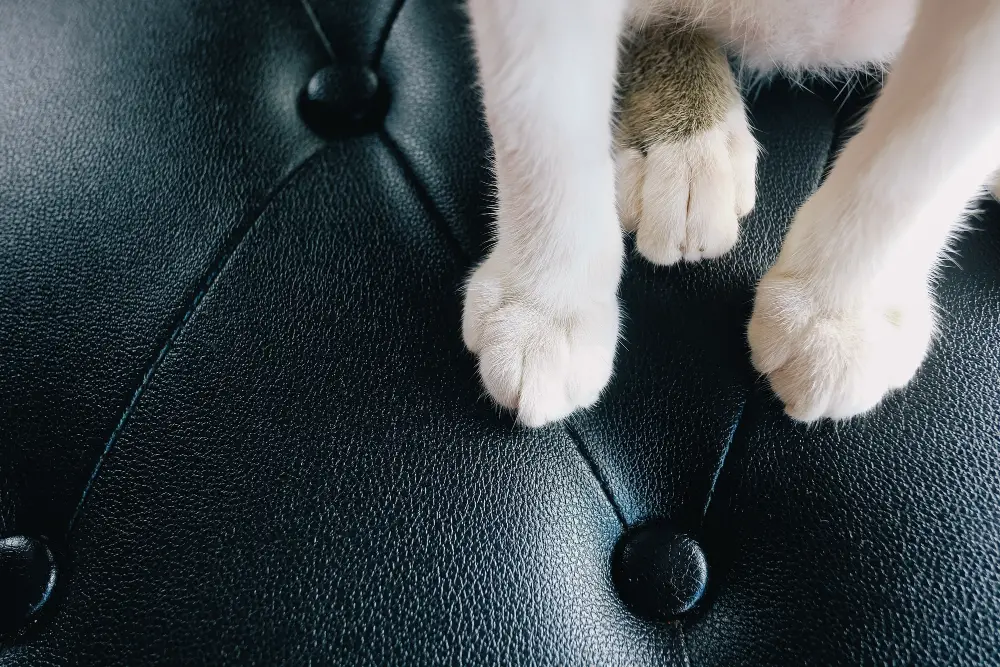
Identifying scratch-prone couches is crucial in preventing damage to your leather furniture. Leather couches with smooth and shiny surfaces are more likely to attract cats because they provide an ideal surface for them to sink their claws into.
Light-colored leather sofas tend to show scratches more prominently than darker ones.
It’s also worth noting that some types of leather are more prone to scratches than others. Aniline and semi-aniline leathers have a soft texture which makes them susceptible to cat scratches compared with pigmented or protected leathers which have a harder finish.
When shopping for new furniture, consider choosing materials such as microfiber or tightly woven fabrics like canvas or denim instead of smooth-textured materials like silk or velvet since these fabrics may be less attractive targets for cats’ claws.
Types of Cat Scratches
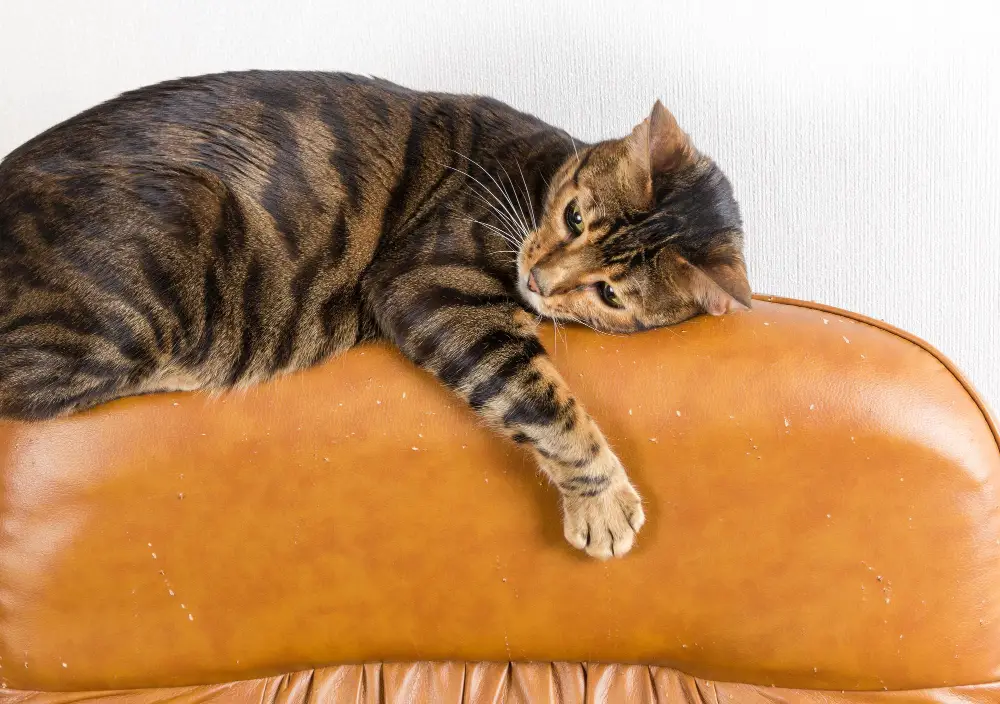
Understanding the types of scratches your cat may leave on your leather couch can help you identify the best way to prevent them from happening in the first place.
One type of scratch is known as “exploratory scratching.” This occurs when cats are exploring their environment or trying to mark their territory. These scratches tend to be shallow and random, with no particular pattern.
Another type of scratch is called “stretching scratching.” Cats use this kind of scratching as a way to stretch out their muscles after sleeping or lounging around. These scratches are usually vertical and long, often found on corners or edges where cats can fully extend themselves.
Lastly, there’s “aggressive scratching,” which happens when cats feel threatened or stressed out. Aggressive scratches tend to be deep and erratic since they’re done in an attempt by felines at self-defense against perceived threats like other animals invading its space.
Preventing Cat Scratches
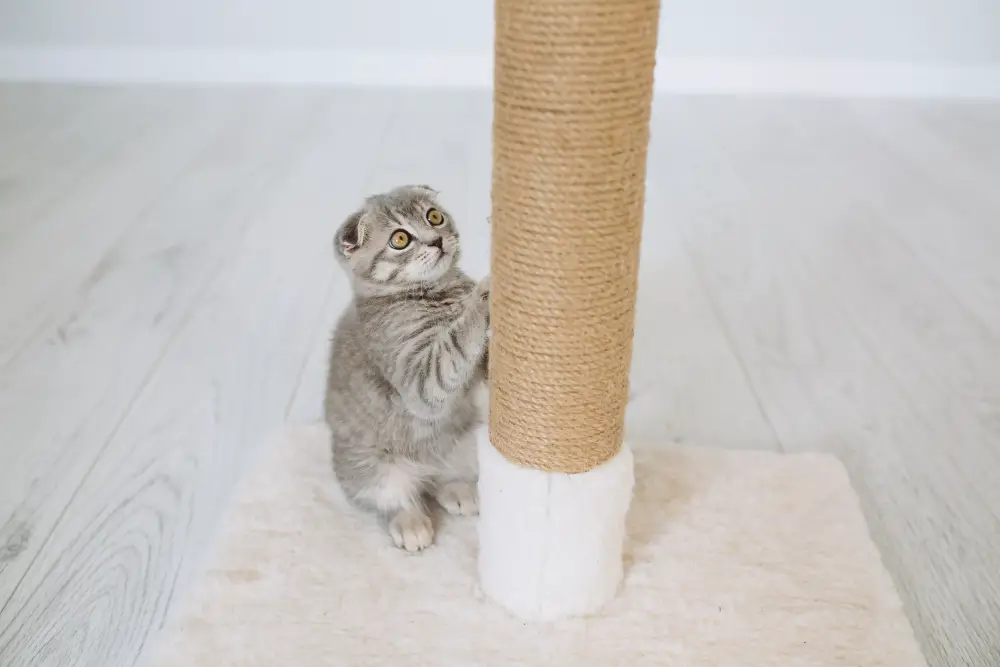
There are several methods you can use to discourage your furry friend from using your furniture as a scratching post.
Firstly, try placing double-sided tape or aluminum foil on areas where cats tend to scratch. The texture and sound will deter them from continuing their destructive behavior.
Another option is providing an alternative scratching surface for your cat, such as a designated scratching post or pad. Encourage them to use it by sprinkling some catnip on top or rubbing it with their favorite toy.
You can also try spraying citrus-scented sprays around the couch since cats dislike this smell and will avoid areas that have been sprayed with it.
Lastly, consider investing in soft paws – plastic nail caps that fit over a cat’s claws – which prevent damage caused by clawing while still allowing normal movement and retractability of nails.
Effective Cat Scratch Deterrents

One of the most popular methods is using a deterrent spray. These sprays work by emitting an unpleasant scent or taste that cats find unappealing and will avoid at all costs.
Another effective method is providing your cat with their own designated scratching post or pad. Cats have an innate need to scratch, so giving them something they can scratch without damaging anything else in the house can be very helpful.
You may also want to consider investing in soft paws for cats – these are small plastic caps that fit over each claw and prevent damage when they scratch on surfaces like leather couches.
Training your cat not to scratch on certain surfaces can be done through positive reinforcement techniques such as rewarding good behavior with treats or toys while redirecting bad behavior away from the furniture you want protected.
Spraying Leather Furniture With Apple Cider Vinegar

Cats have a strong sense of smell, and the scent of apple cider vinegar is unpleasant to them. To use this method, mix equal parts water and apple cider vinegar in a spray bottle.
Then lightly mist the solution onto your leather couches or other furniture that you want to protect.
It’s important not to oversaturate the leather with the mixture as it can damage it over time. You should also test an inconspicuous area first before spraying all over.
While this method may be effective for some cats, keep in mind that every feline has their own personality traits and preferences when it comes to scratching surfaces they like or dislike.
Training Cats to Avoid Scratching

One effective way to train cats is by using positive reinforcement techniques. Start by providing your cat with an alternative scratching surface, such as a scratching post or pad, and reward them when they use it instead of the couch.
You can also try placing double-sided tape or aluminum foil on the areas of the couch that are most prone to scratches, which will deter them from using those spots.
Another technique is to make sure that you’re giving your cat enough attention and playtime throughout the day so that they don’t feel bored or restless and turn their energy towards destructive behavior like scratching furniture.
It’s important not to punish cats for unwanted behavior as this may cause anxiety and fear in them. Instead, focus on redirecting their attention towards more appropriate activities while reinforcing good habits with treats or praise.
Remember that training takes time and patience; consistency is key in helping cats learn new behaviors.
Give the Cat an Alternative

Cats scratch for a variety of reasons, including marking their territory and sharpening their claws. By providing them with a designated scratching post or pad, you can redirect their attention away from your furniture.
When choosing a scratching post or pad, consider the texture and material that your cat prefers. Some cats prefer rougher surfaces like sisal rope while others may prefer softer materials like carpet or cardboard.
Place the alternative in an area where your cat spends most of its time so they are more likely to use it instead of the couch. You can also encourage them to use it by sprinkling some catnip on top or using positive reinforcement when they do scratch on it.
Fake Nails for Cats

Fake nails are a humane and safe alternative to declawing that can help protect both your furniture and your furry friend’s paws.
These nail caps come in different sizes and colors, so you can choose the ones that best match your cat’s claws. They’re easy to apply with a special adhesive that won’t harm their paws or skin.
Once applied correctly, they’ll stay on for several weeks before falling off naturally as the cat sheds its old claw sheaths.
While fake nails may not be suitable for all cats (some cats find them uncomfortable), they’re worth considering if other methods have failed or if you want an extra layer of protection against scratches on leather furniture. Just make sure to follow instructions carefully when applying them and check regularly for any signs of discomfort or irritation in your pet’s paw pads.
.
Cats love scratching things; it’s just part of their nature! However, this doesn’t mean we have no choice but let our beloved feline friends destroy our beautiful leather couches! By understanding why cats scratch furniture in general (and specifically whether they scratch leather) we can take steps towards protecting our homes while still enjoying quality time with our pets.
Leather Couch Protection Tips

One of the most effective ways is to provide your feline friend with an alternative scratching surface. A scratching post or pad will give them an outlet for their natural urge to scratch and keep them away from your couch.
Another way to protect your leather couch is by using a protective cover. There are many covers available that fit snugly over the entire sofa, protecting it from scratches and other damage caused by pets or children.
You can also try spraying apple cider vinegar on areas where cats tend to scratch as they dislike its smell. However, be sure not to spray too much as this may cause discoloration on some types of leather.
Keeping your cat’s claws trimmed regularly will help reduce the likelihood of damage occurring in the first place.
Repairing Scratched Leather

There are ways to repair the scratches and restore your furniture’s appearance. One option is to use a leather repair kit, which typically includes a filler compound that can be used to fill in the scratch and color-matching dye or paint for covering it up.
To begin repairing scratched leather furniture, clean the area around the scratch with rubbing alcohol or another cleaning solution recommended by the manufacturer of your specific type of leather. Then apply a small amount of filler compound over each scratch using an applicator tool included in most kits.
After filling in all scratches with this compound material let it dry completely before applying any coloring agent like dye or paint from within kit onto repaired areas so they match rest part perfectly without looking odd one out due difference between colors caused by wear & tear over time period.
How to Repair Cat Scratches On Leather Furniture Step-by-Step
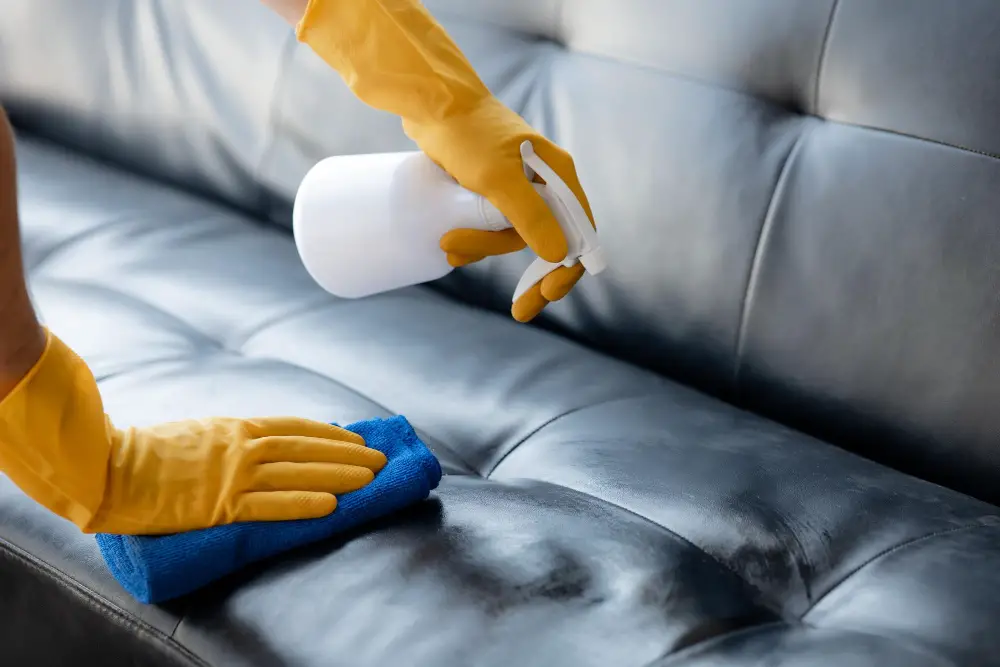
There are ways to repair the scratches and restore your furniture’s appearance. Here is a step-by-step guide on how to repair cat scratches on leather furniture:
- Clean the area around the scratch with a soft cloth and mild soap.
- Use sandpaper or an emery board to gently buff out any rough edges around the scratch.
- Apply a small amount of leather conditioner onto another clean cloth, then rub it into the scratched area in circular motions until it is absorbed by the leather.
- If there are still visible marks after conditioning, use shoe polish that matches your couch color and apply it over each scratch using cotton swabs or Q-tips until they blend in with surrounding areas.
It’s important not to rush through this process as you want to ensure that you’re repairing rather than worsening damage done by cats’ claws.
Cat-friendly Couch Alternatives

One option is microfiber furniture, which is durable and easy to clean. Microfiber also doesn’t scratch as easily as leather or other materials.
Another alternative is furniture made from natural fibers like cotton or linen. These fabrics are soft and comfortable for both you and your furry friend, but they may not be as resistant to scratches over time.
You can also opt for slipcovers that can be removed and washed when needed. This way, if your cat does happen to scratch the fabric underneath, it won’t ruin the entire piece of furniture.
Ultimately, choosing a cat-friendly couch comes down to personal preference and lifestyle needs.
Do Cats Scratch Faux Leather?

While faux leather may be more durable than real leather in some ways, it’s not entirely immune to scratches from cats. Faux leather can still be punctured or torn by sharp claws, especially if the material is thin or low quality.
If you’re considering purchasing faux-leather furniture and have a cat at home, there are steps you can take to minimize the risk of damage. One option is to choose high-quality faux-leather materials that are thicker and more resistant to scratches.
You could also consider using deterrents like double-sided tape or sprays designed specifically for deterring cats from scratching furniture.
Declawing: Pros and Cons

Some believe it’s an effective way to prevent cats from scratching furniture, while others argue that it’s inhumane and can cause long-term physical and behavioral problems for the animal. While declawing may seem like a quick fix, there are several reasons why you should think twice before going down this route.
Pros:
- Prevents damage to furniture
- Can reduce the risk of injury to humans or other animals
- May make cats more adoptable for those with allergies
Cons:
- Painful procedure that involves amputation of part of the cat’s toes
- Can lead to long-term physical problems such as arthritis and nerve damage
- Changes in behavior such as biting or avoiding litter boxes
- Goes against natural feline instincts
As responsible pet owners, we must consider all options when it comes to protecting our homes from scratches without causing harm or discomfort for our furry friends. There are many alternatives available that can help deter your cat from scratching leather couches without resorting to declawing.
Keep Cat’s Claws Trimmed

Regular trimming will not only reduce the damage caused by scratches but also keep your feline friend healthy and happy. Trimming a cat’s claws may seem like a daunting task, but with patience and practice, it can become an easy routine for both you and your pet.
To trim a cat’s claws, start by gently holding their paw in one hand while using the other hand to press down on each toe pad to expose its claw. Use sharp scissors or clippers designed specifically for cats’ nails to cut off just the tip of each claw at an angle that follows its natural curve.
Be careful not to cut too close as this could cause pain or bleeding. If you’re unsure about how much nail should be removed, consult with a veterinarian or professional groomer who can show you proper techniques.
Trimming should be done every two weeks if possible; however, some cats may need more frequent trims depending on how fast their nails grow.
In Closing
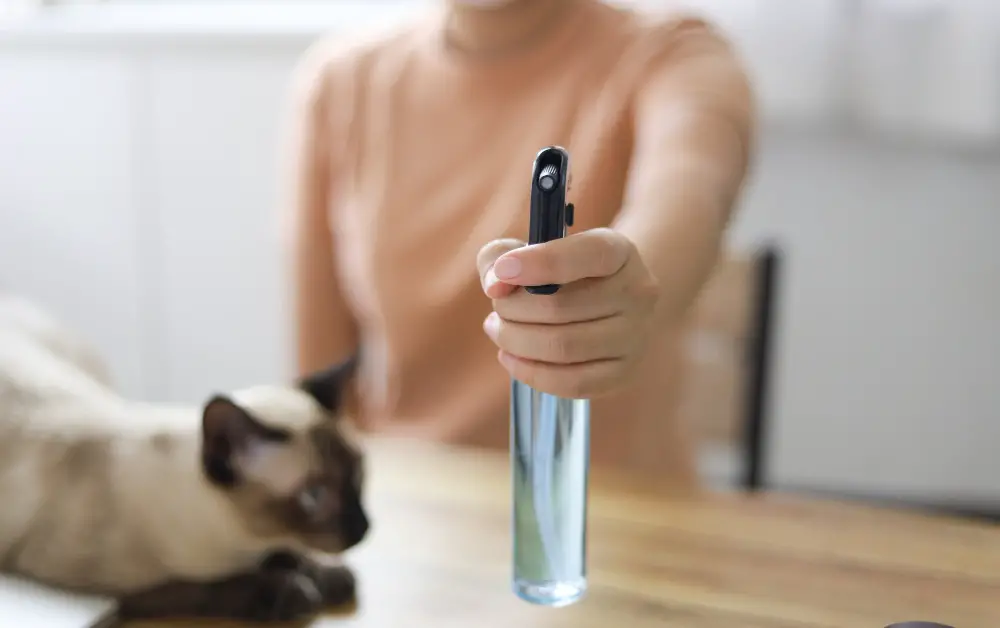
This doesn’t mean you have to sacrifice your leather couches or live with unsightly scratches. By understanding why cats scratch and taking preventative measures such as providing alternative scratching surfaces, trimming their claws regularly, using deterrents like double-sided tape or aluminum foil, and protecting your leather furniture with covers or sprays like apple cider vinegar solution; you can enjoy the company of your feline friend without worrying about damage to your home decor.
Remember that training a cat takes time and patience but is ultimately worth it in the end. With consistent effort on both ends – yours as an owner who wants to protect their investment in quality furnishings while still enjoying all aspects of pet ownership including cuddling up next them for movie night- there’s no reason why everyone can’t coexist happily together!
FAQ
Are leather couches OK with cats?
Leather couches are not the best choice for cats, as their claws can easily damage the material.
How do I make sure my cat doesn’t scratch my leather couch?
To prevent your cat from scratching your leather couch, cover it with a durable plastic-type material during the transition period until your cat learns to scratch on a more desirable surface.
What sofa material that cat won t scratch?
The ideal sofa material that cats won’t scratch is synthetic and microfiber couches, such as polyester, nylon, suede, and acrylic upholstery blends, due to their thin and tougher fabric fibers that are more scratch-proof.
What are the best preventive measures to protect leather couches from cat scratches?
The best preventive measures to protect leather couches from cat scratches include providing alternative scratching surfaces, using deterrent sprays, and regularly trimming your cat’s nails.
Are there any specific types of leather that are more resistant to cat scratching?
Yes, thick and high-quality full-grain leather is more resistant to cat scratching.
How can I train my cat to avoid scratching leather furniture?
To train your cat to avoid scratching leather furniture, provide alternative scratching surfaces, such as scratch posts or pads, and use deterrents like double-sided tape on the furniture.




